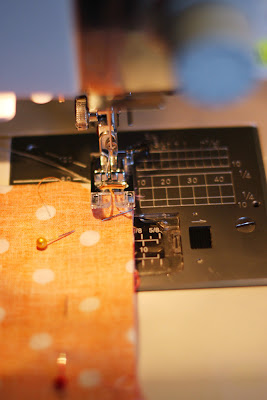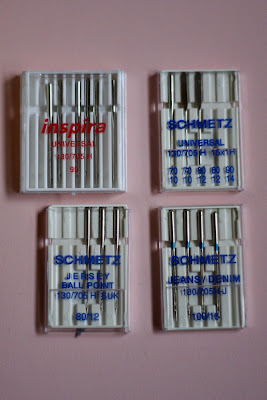HOW TO THREAD A SEWING MACHINE {STEP-BY-STEP}
Learning how to thread a sewing machine is vital when trying to sew any item properly. Therefore it’s the first topic on our new How To Sew series here on Tip Junkie. {squeal!} The fabulous seamstress Andrea is here to show us step-by-step with pictured instructions on the best way for threading a sewing machine.
Welcome to the first of three posts in a mini series, “How To Sew” that will help give you the confidence you need to get your machine threaded, pick the right needle and thread & then get sewing!!
How To Thread A Sewing Machine
 |
| {Photo Credit} |
The BEST help for threading a sewing machine is the machine itself AND the machine’s manual. Unfortunately, a lot of well loved {used} machines don’t come with a manual and sometimes {er, this NEVER happens} we misplace the manual that did come with our machine. Thankfully, most machines give you a step-by-step guide right on their body.

In order to sew, you need two sewing threads. An upper thread {the stitches you see on the top of your piece} and a bobbin {the stitches on the underside of your piece}. In order to wind a bobbin, your machine can not be already threaded and ready to sew {as you need it to go onto the bobbin}. That is why we will cover this step first.
** There are a few machines {like mine} that will wind the bobbin independent of the upper thread, but this is not as common. **
How To Thread A Bobbin
Typically the bobbin threader {winder} is on the top right of the machine and there is a second set of marked guides {usually a dashed line} on the machine to show you how to wind your bobbin. On my machine, then it goes from the spool, through the eyelet and then around a bobbin winding tension disk and over to the bobbin winder. I guide the thread from the underside of the bobbin to the top through the small hole on the outside edge of the bobbin.
Place the bobbin on the bobbin winder spindle, click to the right to engage the bobbin winding and then push the bobbin winding button. Clip off the little tail from where you first wound the bobbin once it is wound. Cut the thread feeding from the spool and remove the bobbin from the winding pin.
Step By Step
Drop your bobbin into the bobbin holder {the mechanism under the needle} and thread according to the guide. Your bobbin should unwind in a counter clockwise direction.
Threading A Sewing Machine
My machine is set up to accommodate two spools of thread, so my top thread {the one that creates the stitches on top of your project) sits upright at the back of my machine. A lot of machines have a horizontal spool pin that the thread goes onto on the top of the machine.
Place your thread {mine is hot pink … because it’s fun and easier for you to see in pictures} on the spool pin. You should be able to ‘lock’ your spool in place by placing a plastic spool holder in front of it to keep it from sliding off the pin while you sew.

Follow the guide on your machine {referring to the manual as needed, if applicable}. Typically you’ll feed your thread through an eyelet {2 on my machine} and then click it into a thread guide {3 on my machine}. From there it will feed to the tension area on the left of your machine.
It should guide into a ‘slot’ {4} and then go down {around the tension dial – 5} and then back up to the thread take up arm {6} that rises up and down when you sew. Use your manual feed, handwheel {the large round knob on the far right end of your machine} to guide the arm to the top most position so you can guide your thread through it.
** I think this is the trickiest step of loading your machine. I always make this step harder than it has to be. If you look close, there should be a little ‘notch’ to guide your thread into the eye of the arm. **
Then follow the remaining guides to get the thread down to your needle. I have an automatic threader which is handy, but with good light and a steady hand you can thread it manually just fine. I thread from the front of the needle to back.

Once your top thread is in place, use your hand-wheel to lower your needle down and then back up. This should ‘grab’ your bobbin thread and bring it up with the top thread. You should have two pieces of thread now. Give them a light pull so you have about 3-5 inches of thread.
Congratulations!! You’re ready to start sewing!!
If you’re looking for a tutorial for your specific machine, YouTube has a several great videos on how to thread your sewing machine and you can Google resources like downloadable manuals for old {and new} sewing machines.
I hope this post gave you the little push you needed to: pull out that machine you’ve been holding onto, ask to borrow one from a friend OR purchase one to work on growing your sewing skills.
Free Sewing Patterns:
- 4 Trendy Ways to Make a Dress {sew}
- 21 Darling Pincushion Patterns To Sew
- 20 Repurposed Kids Clothes Patterns {sew}
In my next post, I’ll cover the different types of threads & needles available and tell you why it DOES make a difference which ones you use {and why}.
I’m Andrea of Knitty Bitties … my little shop that fills my heart as I sew my days away in a wonderful room creating little bits of happy for you. You can read more about my days, my love of iced tea, running, baking & my newest love, our puppy, Daisy girl.































































